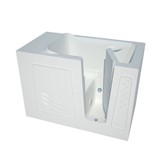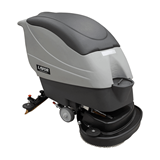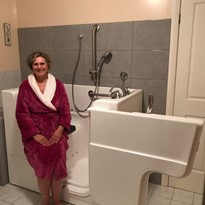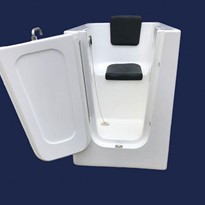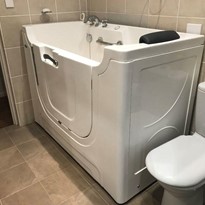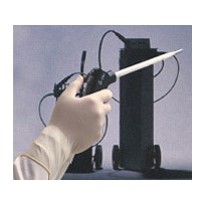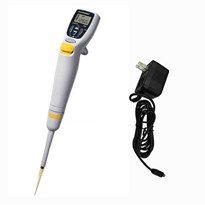What is the first thing you should look for if buying a walk-in bath?
Does it have an inward, or an outward opening door?
Why?
All walk-in baths once had inward-opening doors, because of the difficulty of making outward-opening doors water tight. This was solved by incorporating stainless steel locking pins into outward-opening doors, that close the door tightly against the seal.
Inward-opening doors have a major limitation. To get in and out of the bath, the user has to squeeze into the corner of the bath, to allow the door to swing past the user, to open or close the door. This made for very awkward entry and exit of the bath. This means that as mobility declines, the bath can become unusable.
Outward-opening doors have the whole side of the bath open, to allow easy access in all stages of mobility impairment, from initial stiffness to wheelchair access if needed.
We have been progressively phasing out the old inward-opening door models and only have one still for sale. Our ACCESS, INDEPENDENT and COMPACT models all have outward opening doors.
Other things to look for are:
1. Because you are locked in the bath, you need fast fill taps.
Never buy a walk-in bath without taps fitted. Special fast-fill taps are needed, even for the smallest walk-in bath. They are not available in tap shops, they are custom made.
The taps used on Windsor Baths are made in the UK to the highest standard, to ensure every component of the tapware is designed to fill your bath as quickly as possible. A user of a walk-in bath with standard taps found it took 18 minutes to fill the bath. Fast fill taps deliver 30 to 40 litres a minute [more with 3/4 inlets], standard taps deliver 5 to 15 litres a minute. The worlds’ major vendors use special fast-fill taps for a good reason, most commonly made in the UK, US or Australia.
2. Following on with the above point, the second most important thing is fast draining.
Some walk-in baths come with a low quality, one piece, ribbed hose of around 35mm diameter. This results in a long wait for the bath to drain.
Better walk-in baths come with a complete drainage kit with a 40mm Hepflex hose which is smooth bored inside. This prevents the pipe getting waste matter caught in its internal ribbing, which happens with drains with internal ribs. The extra diameter increases the pipe by one third of extra area, to drain the water that much quicker
3. Does the spa inclusion use water or air?
We use only body-temperature heated air-spas to prevent bruising to delicate skin that a water spa can cause.
Our air-spa system is made for hydrotherapy applications by the worlds’ leading provider in Canada. The system automatically self-purges 20 minutes after usage, to help prevent passing on infections the next time it is used.
The spa jets are designed to prevent skin bruising that can happen with normal spa jets. The 16 jets are roughly the size of a 10 cent coin with 6 outlets on the RIM of each jet. This creates a flower pattern of vigorous massage instead of a centralised blast.
Others use standard water/air systems used in pools and standard spas which cost less than a quarter of the price.
You can turn on a heated-air spa before you enter the bath to heat the bath shell, you can’t do this with a water spa. You can use Radox, aromatic oils etc. without worrying about gumming-up the system. The worlds’ leading vendors like WIBCO in the UK only use air-spas for a good reason.
4. Avoid conventional lay-in type baths unless using it for overhead shower access.
While a door may help you get into the conventional lay-in type bath, the big risk is getting stuck on the floor of the bath. This is why lay-down type baths aren’t fitted into aged care or disability environments in Australia.
As a general rule, if you can’t step into a bath, you are in the high risk category for being unable to get up and out of a lay-in type of bath.
The larger water capacity of lay-in type baths means you are standing [or laying] in the bath for a longer period while it fills.
Can you reach the taps at the foot of the bath? Sit-in baths represent over 98% of walk-in bath sales world-wide.
5. Should you have a hand-held showers incorporated into the bath shell or a wall mounted adjustable shower head?
Because of the weight of a metal flexi hose and shower head that go into the bath body, these are clumsy and difficult to use. Sliding a 1 to 1.5 metre metal hose into the hole in the bath is difficult and clumsy.
This type of shower rarely has a WELS rating as required by Australian Standards.
If they do claim to have a WELS compliance, ask for the compliance number in writing. While some will verbally state anything, we doubt they will claim WELS compliance for this type of ‘into the bath’ type flexi-hose shower if asked to confirm their claim in writing.
To overcome the weight issue, some suppliers use low weight [and quality] metal-looking plastic hoses and plastic showers.
You are better to use a vertical Australian Standards Approved external grab bar above the bath, with an attached, sliding, removable shower head on a flexi hose as shown on the right. Your plumber can supply these for about $350. They are easy to fit, as the flexi-hose screws into the existing shower outlet.
Again, the worlds’ major walk-in bath suppliers, Seabridge Bathing and Premier Baths use this method, as it is far better, safer and easier to use.
6. Will it fit through the doors in your house?
A standard door is 2’8″ wide [81cm] less the door jambs giving you about 31″[79 cm]. If the smallest dimension of a bath you are looking at is over 30″ [76cm] you may not get it through your doors; check this.
7. Be cautious if thinking of a seat-lift or belt-lift in a bath.
These look good in theory, but many people find they feel insecure with these and find the transition from a seated to laying position, and the reverse, very awkward. Many people also find it difficult to reach the taps quickly, this makes scalding more likely. We looked at introducing a bath with a lift seat, but our testing group found them extremely harsh on backs. When the seat took them from a seating position, to a legs-out position, all testers noted extreme back strain. Overall, like a plastic shower chair, a very second rate solution, hence rarely sold in Australia.
8. Australian Standards Compliance.
This is a key issue as it is largely about user safety.
Having Australian sourced plumbing fittings is a key factor here. Ask also where the spa systems come from, and are they installed in Australia to Australian Standards.
Here are questions to ask before buying.
- What is the IP [waterproof] rating of the electrics. Ask for the IP [waterproof] rating IN WRITING [ours are IP X5 rated].
- If there is a hand held shower in the bath, what is the WELS rating?
- Do their spa motors have Australian Compliance test certificates, ask for confirmation IN WRITING.
- Do the spas have multiple one-way water flow protection systems to stop water reaching the 240V electrics?
If there is a heated water-spa, are there TWO thermostats as required by Australian Standards? Failure of a single thermostat model can have tragic results as the water gets hotter and hotter; [yes; they are sold in Australia with fifteen hundred watt water heaters]; think about sitting in a kettle! If a vendor has a water-spa, ask for dual thermostat compliance in writing, this is very important for your safety.
These standards are about giving you a bath that is safe and will give years of trouble free ownership. Don’t compromise your safety and security
Ask for written proof of specific Australian Standards Compliance and written proof of the country of manufacture.



